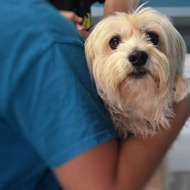Difficult patients are often stressed patients

"Patients are always learning, whether you want them to or not."
"Patients are not giving us a hard time, they are having a hard time," said veterinary nurse Linda Ryan, during her talk on fear-free practice at BVNA Congress this morning (8 October).
The benefits of reducing stress in patients are numerous. As well as the obvious implications for animal welfare, it also boosts client trust in their veterinary practice, reduces the threat of injury to staff and patients, and improves staff morale and efficiency.
As veterinary professionals, Linda said, we should be looking out for signs of stress and responding to them. No animal wants conflict so aggression will often be the last resort. Ignoring or missing these signs could have a lasting impact on the animal.
"Patients are always learning," Linda added, "whether you want them to or not. So make sure you are teaching the right things."
Pinning an animal down or using force only serves to increase stress in an already stressed animal, making the task even harder the second time around. Instead, operant conditioning can be used to effectively train them to accept certain medications, procedures or examinations, Linda said.
She showed delegates a video of herself applying this method to densensitise a cat that had become afraid of having nasal drops. She gradually acclimatised the patient to accept the dropper through clicker training, until it actively approached her for its treatment. At all times, she waited for the animal's engagement before continuing, and the cat was free to walk away at any time.
First and foremost, Linda advises making a plan before each consultation, setting out your approach and plan B if things go awry. Make sure you have all equipment within reach so you can keep up a continual, gentle contact with the animal (if they are comfortable with it) - rather than having to keep coming and going. Minimal restraint, if any, is ideal.
It's important to learn how to read body language, to be prepared to prevent and manage problems, take your time, and educate owners. Place animals on a soft, stable surface and always let them sit or lie in a natural position, then work around them. Avoid startling them by using slow, gentle handling and speech.
Ask yourself at all times, 'Does this have to be done?', 'Does it have to be done now?', 'Should we send the patient home and bring them back in another day?', 'What's in it for the pet?' and 'How can I make this the best experience possible for the patient?'. Unless it's an emergency, in some cases it may be prudent to leave it for another day if the patient is stressed.
Another key tip is to clean thoroughly between each patient with an enzymatic cleaner that removes, rather than masks, the scent of the previous animal. Many species exude 'alarm' pheromones that act as a warning to the new patient before you have even begun. Remember to do this with all equipment, including muzzles.
Client education is key and nurse clinics can be highly valuable in helping owners and breeders to learn about socialisation, how to get cats used to carriers and pets used to car journeys and new environments. Training pets to partake in examinations of the paws, ears, mouth and tail is also very useful.
The take-home message to nurses was to take the first step, even if it's only possible to take just a few of these tips back into practice.



 The RCVS has announced a new version of its 1CPD mobile app, with enhanced features for veterinary surgeons and veterinary nurses to record their continuing professional development.
The RCVS has announced a new version of its 1CPD mobile app, with enhanced features for veterinary surgeons and veterinary nurses to record their continuing professional development.